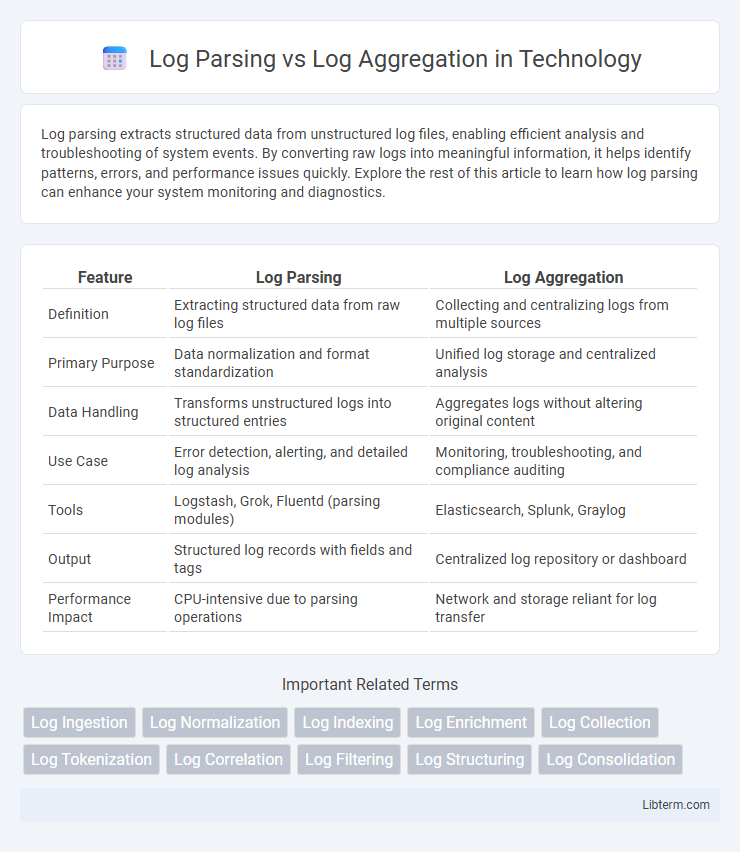Log parsing extracts structured data from unstructured log files, enabling efficient analysis and troubleshooting of system events. By converting raw logs into meaningful information, it helps identify patterns, errors, and performance issues quickly. Explore the rest of this article to learn how log parsing can enhance your system monitoring and diagnostics.
Table of Comparison
| Feature | Log Parsing | Log Aggregation |
|---|---|---|
| Definition | Extracting structured data from raw log files | Collecting and centralizing logs from multiple sources |
| Primary Purpose | Data normalization and format standardization | Unified log storage and centralized analysis |
| Data Handling | Transforms unstructured logs into structured entries | Aggregates logs without altering original content |
| Use Case | Error detection, alerting, and detailed log analysis | Monitoring, troubleshooting, and compliance auditing |
| Tools | Logstash, Grok, Fluentd (parsing modules) | Elasticsearch, Splunk, Graylog |
| Output | Structured log records with fields and tags | Centralized log repository or dashboard |
| Performance Impact | CPU-intensive due to parsing operations | Network and storage reliant for log transfer |
Introduction to Log Parsing and Log Aggregation
Log parsing involves extracting structured data from raw log files by identifying key fields and patterns, enabling efficient analysis and troubleshooting. Log aggregation collects and centralizes logs from multiple sources into a single platform, easing monitoring and correlation across distributed systems. Combining log parsing with aggregation enhances real-time visibility, enabling faster incident detection and response.
Defining Log Parsing
Log parsing involves extracting structured data from unstructured log files, converting raw log entries into meaningful, searchable information. It enables the analysis of specific fields, such as timestamps, error codes, and user IDs, facilitating faster troubleshooting and monitoring. Unlike log aggregation, which centralizes logs from multiple sources, log parsing focuses on interpreting and formatting the data for detailed insights.
Understanding Log Aggregation
Log aggregation is the process of collecting and centralizing log data from multiple sources into a unified platform to improve monitoring, analysis, and troubleshooting. It enables IT teams to efficiently manage large volumes of logs by providing real-time insights, correlation of events, and simplified access to distributed log files. Unlike log parsing, which extracts specific information from logs, log aggregation focuses on consolidating diverse log data to support comprehensive system visibility and faster incident response.
Key Differences Between Log Parsing and Log Aggregation
Log parsing involves extracting and structuring data from raw log files to enable detailed analysis, whereas log aggregation refers to the centralized collection and storage of logs from various sources for easy management. Key differences include log parsing's focus on transforming unstructured log data into a structured format, enabling enhanced search and correlation, while log aggregation emphasizes consolidating logs for unified access and monitoring. Parsing enables deeper insights by interpreting the content of logs, whereas aggregation improves operational efficiency by providing a single repository for log data.
Use Cases for Log Parsing
Log parsing is crucial for extracting structured data from unstructured log files, enabling precise error detection, performance monitoring, and security analysis in IT operations. Use cases include real-time troubleshooting by identifying specific error codes, compliance auditing through detailed activity records, and proactive threat detection by parsing security logs for anomalies. By transforming raw logs into actionable insights, log parsing enhances system observability and accelerates incident response across diverse computing environments.
Use Cases for Log Aggregation
Log aggregation centralizes log data from diverse sources into a unified platform, enabling real-time monitoring, security analysis, and troubleshooting across distributed systems. Use cases for log aggregation include detecting security breaches by correlating events, improving application performance through comprehensive error tracking, and supporting compliance requirements with consolidated audit trails. This centralized approach enhances operational visibility and accelerates incident response in complex IT environments.
Benefits of Log Parsing
Log parsing enhances the value of raw log data by extracting structured information such as timestamps, error codes, and user IDs, enabling precise and efficient data analysis. This process improves anomaly detection, root cause analysis, and real-time monitoring by converting unstructured logs into actionable insights. Compared to log aggregation, which simply consolidates log data from multiple sources, log parsing facilitates better decision-making through enriched data quality and faster troubleshooting.
Advantages of Log Aggregation
Log aggregation centralizes log data from multiple sources into a single platform, enhancing the efficiency of log management and analysis compared to individual log parsing. This centralized approach enables faster anomaly detection, streamlined troubleshooting, and improved operational visibility across distributed systems. By consolidating logs, organizations can leverage advanced analytics and real-time alerting to proactively maintain system health and performance.
Choosing the Right Approach: Parsing vs Aggregation
Log parsing extracts structured data from raw log files by analyzing and transforming entries into searchable formats, ideal for detailed error diagnosis and real-time monitoring. Log aggregation collects logs from multiple sources into a centralized repository, optimizing large-scale data storage and unified access for trend analysis and compliance auditing. Selecting between parsing and aggregation depends on the need for granular insight versus comprehensive log collection and the architecture of existing observability tools.
Conclusion: Integrating Parsing and Aggregation for Effective Log Management
Integrating log parsing and log aggregation enhances log management by enabling structured data extraction and centralized storage, facilitating faster analysis and troubleshooting. Parsing transforms raw logs into consistent formats, while aggregation consolidates data from multiple sources, improving visibility across distributed systems. Combining both processes ensures efficient monitoring, anomaly detection, and actionable insights for IT operations.
Log Parsing Infographic

 libterm.com
libterm.com